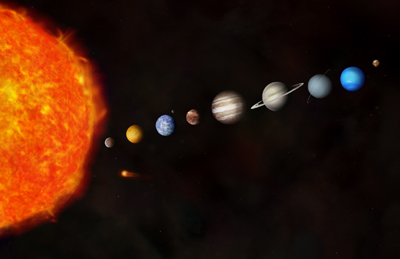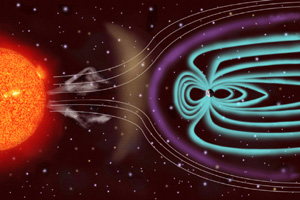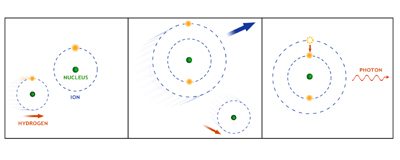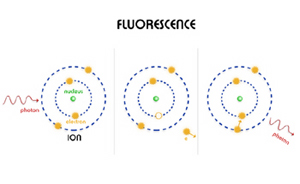The Sun's corona, or hot outer atmosphere, produces X-rays but it is too close and bright for Chandra to observe with its extremely sensitive detectors. An X-ray image of the Sun, courtesy of The Soft X-ray Telescope on board the Yohkoh satellite is shown on the right. This telescope was specially designed to study the solar corona, which has a temperature of about 2 million degrees Celsius.
Although planets, satellites and comets have temperatures well below the millions of degrees typically needed to produce cosmic X-rays, these cooler objects have been found to produce X-rays in a variety of ways. X-radiation from solar system objects provide important information difficult to come by with other telescopes.
Earth's Geocorona
Very close to home, Chandra has detected evidence of X-rays from Earth's geocorona (extended outer atmosphere) through which Chandra moves. The geocoronal X-rays are caused by collisions between hydrogen atoms in the geocorona with carbon, oxygen and neon ions that are streaming away from the Sun in the solar wind.
This process, called "charge exchange" because an electron is exchanged between a neutral atom in the atmosphere and an ion, typically carbon, nitrogen, or oxygen, in the solar wind. After such collisions, X-rays are emitted as the captured electrons move into tighter orbits. These X-rays have an energy that is equal to the difference in energy states for the electron orbits. The spectrum, or overall distribution of X-rays with energy from charge-exchange collisions can be distinguished from other processes with a sensitive X-ray spectrometer, and provide evidence that the charge-exchange collision is occurring.
Comets
The charge exchange process operates throughout the solar system. It is especially important for comets, which have extended atmospheres. Comets resemble "dirty snow balls" a few miles in diameter with a surrounding cloud of dust and gas. By observing X-rays due to charge exchange in the cometary atmosphere, it is possible to study the elements present in the solar wind, the structure of the comet's atmosphere, and cometary rotation. In the future it may be possible to detect X-radiation from collections of hundreds of comets around stars other than the Sun. Young stars would be the most promising candidates because they have vigorous stellar winds.
The Moon
Chandra has been used to prospect for elements on the Moon. X-rays from the Moon are caused by "fluorescence" due to the impact of solar X-rays on the surface of the Moon. When a solar X-ray is absorbed by an atom on the lunar surface, the X-ray knocks an electron out of the inner part of the atom and excites the atom to a higher energy level. The atom almost immediately returns to its lower energy state with the emission of a fluorescent X-ray. In a similar way, ultraviolet light produces the visible light of fluorescent lamps. The energy of a fluorescent X-ray is unique to the particular type of atom, so fluorescent X-rays give a direct measurement of elements present, independent of assumptions about the type of mineral or other complications.
Oxygen, magnesium, aluminum and silicon were detected over a large area of the lunar surface. Longer observations of the Moon with Chandra, should help to determine if the Moon was formed by a giant impact of a planetoid with the Earth about 4.5 billion years ago, or by some other process.
Venus
The X-rays from Venus and, to some extent, the Earth, are due to the fluorescence of solar X-rays striking the atmosphere. Chandra's image of Venus shows a half crescent due to the relative orientation of the Sun, Earth and Venus. Solar X-rays are absorbed about 120 kilometers above the surface of the planet, knocking electrons out of the inner parts of atoms, and exciting the atoms to a higher energy level. When the atoms almost immediately return to their lower energy state, they emit a fluorescent X-ray. In contrast to the X-radiation, the optical light from Venus is caused by the reflection of sunlight from clouds 50 to 70 kilometers above the surface.
Mars
Fluorescent X-rays from oxygen atoms in the Martian atmosphere probe heights similar to those on Venus. A huge Martian dust storm was in progress when the Chandra observations were made. Since the intensity of the X-rays did not change when the dust storm rotated out of view, astronomers were able to conclude that the dust storm did not affect Mars's upper atmosphere. They also found evidence that Mars is still losing its atmosphere into deep space.
A faint halo of X-rays was also detected some 7,000 kilometers above the surface of Mars. These X-rays are presumably due to the solar wind charge-exchange process operating in the tenuous extreme upper atmosphere of Mars.
Jupiter
Jupiter has an environment capable of producing X-rays in a different manner because of its substantial magnetic field. X-rays are produced when high-energy particles from the Sun get trapped in its magnetic field and accelerated toward the polar regions where they collide with atoms in Jupiter's atmosphere. Chandra's image of Jupiter shows strong concentrations of X-rays near the north and south magnetic poles. The weak equatorial X-ray emission is likely due to reflection of solar X-rays.

Chandra Image of Io and Europa
Reference: Elsner et al.
The Astrophysical Journal, 572:1077-1082, 2002 June 20
Europa, Io and the Io Plasma Torus
Weaker X-ray signals have been detected from two of Jupiter's moons, Io and Europa, and from the Io Plasma Torus, a doughnut-shaped ring of energetic particles that circles Jupiter. Gases such as sulfur dioxide are produced by Io's volcanos, escape from Io and are trapped in an orbit around Jupiter, where they are accelerated to high energies. Collisions between the particles within the Io Plasma Torus, and with the surfaces of Io and Europa can account for the observed X-rays.
Saturn
Like Jupiter, Saturn has a strong magnetic field so it was expected that Saturn would also show a concentration of X-rays toward the poles. However, Chandra's observation revealed instead an increased X-ray brightness in the equatorial region. Furthermore, Saturn's X-ray spectrum, or the distribution of its X-rays according to energy, was found to be similar to that of X-rays from the Sun. This indicates that Saturn's X-radiation is due to the reflection of solar X-rays by Saturn's atmosphere, the same process that may be responsible for the weak equatorial X-radiation observed from Jupiter. Further observations should help clarify whether Saturn's magnetic polar regions ever flare up in X-rays, as do Jupiter's.
Titan
Astronomers have used the lack of X-rays from Saturn's largest moon, Titan, to draw some interesting conclusions. On January 5, 2003, Titan - the only moon in the solar system with a thick atmosphere - crossed in front of the Crab Nebula, a bright, extended X-ray source. Titan's transit enabled Chandra to image the one-arcsecond-diameter X-ray shadow cast on Chandra by the moon. This tiny shadow corresponds to the size of a dime as viewed from two and a half miles. The diameter of Titan's shadow was found to be larger than the known diameter of its solid surface. This difference in diameters yields a measurement of about 550 miles (880 kilometers) for the height of the X-ray absorbing region of Titan's atmosphere. The extent of Titan's upper atmosphere is consistent with, or slightly (10-15%) larger, than that implied by Voyager I observations made at radio, infrared, and ultraviolet wavelengths in 1980. Saturn was about 5% closer to the Sun in 2003, so increased solar heating of Titan may have caused its atmosphere to expand.














